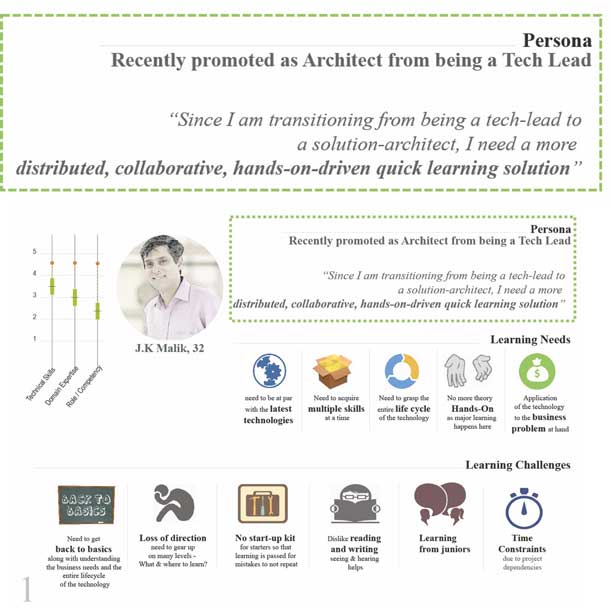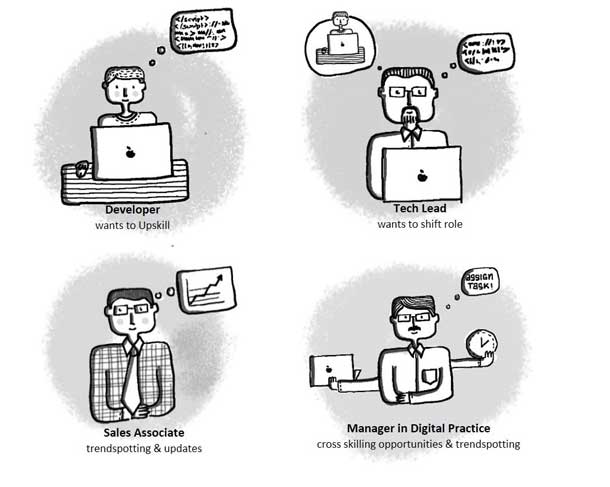
Corporations never cease to want a more competent, decisive, and creative workforce. At the same time, they exercise firm control over their employee base, which is reflected in their employee training and development programs. Corporate training and learning is characterized by mandated certifications that directly impact promotions. The training usually has to be achieved within a given timeframe, in a monotonous and tedious environment, and often includes stiff competition.
Such programs can be a bane for the global workforce’s tech-savvy millennials—a generation characterized by great receptivity to change and constant growth, to challenges, and to new opportunities. The rigid top-down approach to people development is not only proving to be counterproductive, but oppressive as well. With the backdrop of retaining and nurturing millennials, skill development has to suit the generation’s natural tendencies for growth. In today’s interconnected world where equitable access to knowledge resources has become a necessity, companies need to provide a more open, vibrant, and personalized learning environment.
Crafting an Alternative
The millennial generation, with its incessant yearning for self-expression, gravitates towards explorative, more personalized learning methods and environments. This is evident, in part, from the popularity of internet searches for Massive Open Online Courses (MOOCs) and even social media as avenues for learning and sharing.
I participated in the paradigm shift in the making as part of Mindtree Ltd., a global IT corporation, while leading the user experience design for its newly launched e-learning platform Yorbit. Designed for Mindtree’s employees, Yorbit supports a rich learning culture that is a departure from the traditional training framework.

The Yorbit project was kick started by a 2014 global survey of Mindtree employees that flagged the need for a more approachable, accessible, and open format for training in the organization.
User personas were generated from layers of focus group surveys, interviews, and ethnographic observations (see Figure 2). “Learn at your place, pace, and time,” was the motto of the core team from the outset, as self-directed learning was the underpinning of the design approach.
Self-directed learning is empowering; it gives the learner control to decide what content is relevant. Such an approach is believed to increase attention and memory retention; the recall value of the information consumed is certainly higher. However, user-led learning demands a certain attitude more than aptitude. A sense of motivation, responsibility, and timely achievement are key drivers for this approach. So the goals for Yorbit were to create a virtual environment that could optimize the learning experience, increase learning efficacy, sustain momentum, and tame the frivolity that could accompany user-driven learning.
User-curated curriculum
The learning path in Yorbit was introduced to become the user’s personal log. It’s designed so that users curate their own curriculums from an assortment of content selected from the portal and across the web. Multiple learning plans can be created to pursue different interests. Once consumed, the content rests in a repository and can be retrieved for future reference. The learning path provides an impetus for self-driven learning by offering an environment for:
- Focus: Encourages content curation first—then learning—for more attentive sessions
- Organization: Provides structure and a way to track effort and achievements
- Consume in bits: The learning objective may be ambitious, but best practices emphasize small segments studied at a consistent pace. The UI reduces information overload by only showing chunks from the assorted content that are relevant for the featured activity.
- Discuss and debate: Each course has a dedicated discussion forum where learners and experts can discuss and collaborate on the content
- Archive: Easy saving and retrieval of the consumed content
- Consistency: Triggers refresh the information for users who have been absent for long periods
- Access to digital lab: A virtual mockup of a lab environment hosts licensed software to carry out practical assignments
Content sourcing and curation
MOOCs have disrupted the existing training ecology within enterprises. Companies can harness the mammoth potential of these digital offerings to create solutions that best fit their context. The sourcing framework of Yorbit includes an amalgamation of content from partnering MOOCs, YouTube, and material generated from experts within the organization.
Information overload is undoubtedly an issue. A problem unearthed during user surveys was the dilemma of choosing one source from a plethora of options. The design strategy includes the company’s domain experts’ gathered content from partnering MOOCs to meet a certain learning objective. This assortment is called a “package” and it’s made up of consumable bits of information, each carrying a weight upon completion. Package typologies morph according to the learning pedagogies and the domain knowledge they represent, and the plan is to open up sourcing even more by enabling users to upload their own content, which could be tracked and validated by the administrator, and rated by peers.
Bites for all sizes
According to user surveys, one of the top reasons employees shy from training programs is the lack of time to commit to a course. After an intense day at work, who wants to dedicate themselves to hours of training? Can the same learning objective be accomplished in short installments instead?
The Mindtree design team organized Yorbit’s packaged content into chunks that can be consumed fairly quickly. None of the topics exceeds an hour and each has a logical conclusion. The main topic is bolstered by a handful of videos that are 10-15 minutes long. The result is that the intimidating larger objective is broken down into smaller, achievable milestones. The design provides an environment that is conducive for engagement, that enables easy mobile access for on-the-fly learners, and that aids in the synthesis of the information consumed.
Multi-faceted employees
It’s understandable for employees to enter the workforce with a hazy career map in mind, but a few years in an industry could provide a sense of purpose and ambition. Therefore, the inability to move up or branch out within a company could lead to frustration, inefficiency, and demotivation.
Initial user research and persona study pointed to employees’ restiveness in their current roles and the urge to move toward a newfound motivation (see Figure 3). While users did not explicitly state the need for cross-training in the user interviews, the descriptions of monotony and tediousness in their positions made such training an obvious part of the solution. Moreover, what would it mean for a business to have an employee base capable of maneuvering between more than one domain? Companies need a flexible workforce not only to tackle contingencies and seasonal lows, but to move towards a culture of active learning and innovation.

Hence, from the beginning, the design strategy included plenty of opportunities for cross training. Building a force of multi-skilled employees is as critical to an organization as the development of domain expertise.
Generation Me and Personalization
The business world has slowly come to realize that one size cannot fit all. And in the case of millennials, personalized learning is key to progressive education and skill development. Digital technologies having enabled and enriched personalized experiences across domains, and there is an abundance of potential for the growing e-learning community.
A personalized environment is incomplete without recommendations and timely reminders across channels. A combination of a front-end wizard and intelligent back-end logic provides recommended content for each user, making the experience familiar and engaging. Timely reminders sent to users’ mobile apps are included to encourage frequent usage patterns. Care is taken to ensure they are not too frequent, as the reminders could become a nuisance instead of a welcome nudge.
Gentle gamification
From what we post on social media, to instant bonuses for going the extra mile at work, to online purchasing habits, to choosing who we will date, haven’t we all begun to expect instant gratification? With the miniscule levels of patience and heightened receptivity to boredom of today’s employees, it certainly would not help to hold the reward until completion. Yorbit quickly on-boards learners to sustain momentum. With our innate desire to learn and pre-disposition for play, a subtle undertone of gamification should increase learning efficacy. The gamified experience is designed to:
- Provide a sense of accomplishment
- Secure a sense of recognition within the community
- Enable instant feedback for the learning behavior
- Foster collaboration and friendly competition
Social learning
Have you ever participated in a study group for a big exam? Each member was given the ownership of a segment of the hefty content and tasked to make it brief and palpable to others. The experience was dynamic, motivating, and—most importantly— collaborative. How can we translate this experience to the virtual environment?
Discussion forums and micro-blogging contribute to observational learning and a culture of sharing. However, because of the large scale that these features cater to, they seldom succeed in bringing out the desired intensity of collaboration. This observation during user studies pointed the design team towards interconnected systems that could:
- Dynamically create and dissolve groups for problem solving
- Encourage study groups and provide impetus for their learning efforts
- Stimulate synergy and cooperation between groups
- Facilitate local meet-ups as the best solution lies in the “phygital” (physical and digital) space when it comes to interacting with peers
Design By the People, For the People
The people-centric goals of Yorbit required a people-centric design directive. Therefore, collaboration and larger consensus was key. Every member of the multi-disciplinary core team had to approach “Learn at your place, pace, and time.” from their own design sensibilities, which led to a much richer value proposition. And as the designer, it was exciting not only to spearhead the design process, but to facilitate the desired outcomes by integrating people, ideas, events, and processes to aid the overarching objectives. Yorbit is changing training and learning at Mindtree. Will others do the same?
Disclaimer: All views expressed in the above article are my own and do not represent the views of my employer.
Description of Figure 3: Persona: Recently promoted as Architect from Tech Lead
- R. Malik, age 32
“Since I am transitioning from being a tech-lead to a solution architect, I need a more distributed, collaborative, hands-on-driven quick learning solution”
Learning Needs
- To be at par with latest technologies
- Acquire multiple skills at a time
- Grasp the entire lifecycle of the technology
- No more theory. Hands on as major learning
- Application of the technology to the business problem at hand
Learning challenges
- Need to get back to basics along with understanding the business needs and the entire lifecycle of the technology
- Loss of direction. Need to gear up on so many levels. Where and what to learn.
- No startup kit for starters so that learning is passed for mistakes not to repeat
- Dislike reading and writing. Seeing and hearing helps
- Learning from juniors
- Time constraints due to project dependencies
Skills scale
- Business skills: 3.5 out of 5
- Domain expertise: 3 out of 5
- Role Competency: 2.5 out of 5
[/greybox]
